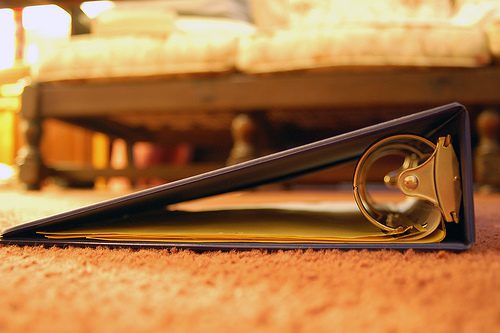September is a popular time for reorganizing and simplifying, and if you haven’t been using a home management notebook — or it’s been a while since you’ve revamped it — this is a great time to spend some time working on yours!
Typically kept in a 3-ring binder, a home management notebook holds everything you need to run your household, all in one convenient location.
Table of Contents
The What & The Why
The overarching purpose of a home management notebook or binder is to build a command center that holds all of the information anyone in the family needs regular access to; however. There are many different ways that individual families use their notebooks.
For instance, many people include their actual “household management” tasks in their folders, including finances, homeschooling, managing contact lists, calendars, etc. As morbid as it sounds, a household management notebook can be an invaluable resource for someone who loses their spouse suddenly so that they’re not left floundering to figure things out in the midst of their grief. Having a home management notebook is a way to ensure that they have all of the information they need at their fingertips.
For some people, a home management notebook becomes more of a “second brain” on a day-to-day basis. It houses their to-do lists, brainstorming, and more. The benefit of using your notebook this way is that you keep everything you need in one place rather than having multiple systems. The downside is that a binder is much larger and less portable than a small notebook or day planner.
And still, other people create yearly binders in place of a filing system so that the whole notebook can then be archived for recordkeeping purposes.
As with all organizing projects, the key is to have a clear vision for your notebook as you decide which information to include and which to keep separate.
Choosing Categories
The truth is that no two household management binders will look the same. There are several basic categories that most people will want to include, but the rest should reflect your own lifestyle and needs.
Before I list some common categories, I want to stress one important point: Please do not look at this list and let yourself become overwhelmed by the thought that you must include every category. Some notebooks contain just a few sections, while others may contain eight or more — or even span several separate notebooks.
If your vision for your notebook seems overwhelming to start, pick up a couple of packs of tab dividers and then leave the tabs blank for now. Start with three basic tabs — emergency information, contacts, and calendars — and fill those sections without worrying about the rest. Once those are done, you can begin working on additional sections. Your notebook does not have to be completed in a single weekend, and you’ll find that it becomes a better resource if you think of it as a work in progress rather than a one-time project.
Use this list of example categories as a starting point for brainstorming about what you want to include in your binder:
- Bible Study (lessons, notes, resources)
- Calendars (your family calendar, sports schedules, school calendars)
- Christmas Planning (gift lists, traditions, activities, recipes, to-do lists)
- Chores (daily, weekly and monthly chores, chore charts for the kids)
- Contacts/Phone Lists (your address book, team phone lists, church directories)
- Daily To-Do List
- Emergency Information (emergency contacts, basic medical information)
- Family Goals & Mission Statement
- Finances (budget, financial goals, account information, passwords)
- Home inventory
- Holiday/Seasonal (home decor inventory, project ideas)
- Homeschool -or- School Records (records for each child, curriculum, upcoming events)
- Ideas/Brainstorming (blank paper for jotting down ideas, page protectors for magazine articles)
- Inspiration (inspirational quotes, articles, etc.)
- Menu Planning (weekly or monthly menu plan, favorite recipes, recipes to try, pantry and freezer inventory)
- Note Pages for your Home Management Notebook
- Shopping (shopping lists for each store, list of coupons in your stash)
- Schedule/Routines
- Christmas binder cover for your Christmas binder
You might include those records if you work at home or run your own business. You also might have a section for your hobbies — gardening or quilting, for example — or for your volunteer activities or organizations you’re active in.
Getting Started
To get started, think about the information you want to include in your notebook. Gather any papers you have scattered throughout your home — for example, those in your kitchen junk drawer or across the top of your desk — and begin sorting them into categories to get an idea of the type of information you regularly refer to.
Think through your vision for your notebook. Is your goal to create a notebook to assist you in the day-to-day management of your home? Or is your focus on having a reference binder or yearly archive?
Also, take some time to think about the supplies you want to use. Are you hoping to create a “pretty” system, or is the function all that matters to you? How many tabs do you want to use? Will you be choosing a set number of categories or leaving blank tabs so that you can expand over time?
Although your system will evolve over time, as it should, spend some time thinking about what you’re looking for in a home management notebook now and then work from there!
10 Reasons Not to Use a Home Management Notebook
In the spirit of my Top 10 Reasons, You Shouldn’t Plan a Weekly Menu post, I wanted to share the top 10 reasons you shouldn’t use a home management notebook either!
10. You like sending family members on treasure hunts around the house for various pieces of paper with important information on them.
9. You’d rather spend 15 minutes every day looking for information than a couple of hours over one weekend to get it organized.
8. If you get organized, you might actually have time to do something you enjoy, and then “they” will accuse you of sitting around and eating bon-bons all day.
7. Having a home management notebook would ruin your spontaneous and laid-back image.
6. You’re not quite sure what you want, and if it’s not going to be perfect, there’s no point in doing it at all.
5. You don’t like to follow the crowd, and since home management notebooks are a popular tool, you’re just not gonna do it.
4. Keeping everything in one place would mean you’d have to stop ignoring the budget and meal plan.
3. You never forget anything, so there’s no reason to write it down.
2. You really don’t like paper products and office supplies, and the thought of having to look at a cute notebook all the time makes you sick.
1. As long as you’re the only one in the know when it comes to running your household, you don’t have to worry about your family replacing you.

Supplies for Your Home Management Notebook
As you get started, you may be tempted to buy every office supply imaginable to make your system just right (please tell me I’m not the only one who’s compulsive about paper and office supplies!). On the other hand, you may wonder which supplies are necessary to make this system work. The good news is not much!
Let’s take a look at some of the most common supplies:
- Binder. The binder is the backbone of the whole system. You can start with a 1″ binder, but — depending on what purpose your home management notebook will serve — you may need to upgrade to a larger one at some point.Binders can be found for as low as $1 in plain, utilitarian colors. However, if you have a little more to spend, buying a binder that appeals to you visually is a good way to motivate yourself to use the system consistently. I also think these zippered binders would be great for a household management system, especially if you use it daily and want to take it with you on the go. The poly binders by Company Folders are extremely durable, which makes them an excellent choice if you want your notebook to last a long time. Download printable binder covers.
- Tab Dividers. Tab dividers are another necessity of home management notebooks because they allow you to divide the information into categories for easy reference. They typically come in packs of 5, 8, 10, 12, or 15, so you’ll want to have a general idea of how many categories you will use before choosing a set. Again, there are many different features to consider, but the least expensive tab dividers start under a dollar. You’ll want to choose between tabs that allow you to insert a label versus those that you write on. Some come with printable stickers and templates so that you can print your labels, and you can also get tab dividers with rewriteable tabs. And depending on your needs, you may choose ones with pockets or page protectors.
Truly, a basic binder and tab dividers is all you need to get started, and you can get started today for under $2, so don’t let cost be a factor in delaying this project!
- Other Supplies. That said, there are other things that can help you take your binder to the next level:
- Page protectors for holding temporary paperwork like permission slips, invitations, etc., or for recipes and crafts from magazines
- Folders for keeping bills, paperwork, and other important records together
- Zippered pouch for holding your supplies, such as pens, post-it notes, calculator, etc.
- Post-it flags for marking pages within sections that need attention or that you refer to frequently
- Highlighters or colored pens (or these highlighters with built-in post-it flags!), for color-coding your calendar, to-do list, meal plan, and more
Home Management Printables
The Life Your Way printables collection contains more than 75 printables for your home management notebook in both full- and half-sheet size.
Here are my favorites, but be sure to browse the full list for even more:
- Monthly Calendars
- And more...
Remember, your home management notebook should reflect you and your needs, and there’s no right or wrong way to do it.
Do you use a home management notebook? If so, what do you think is the biggest benefit?




